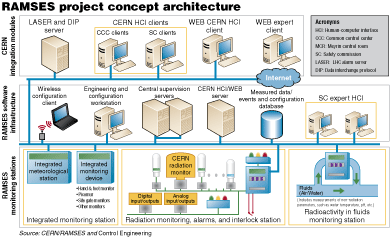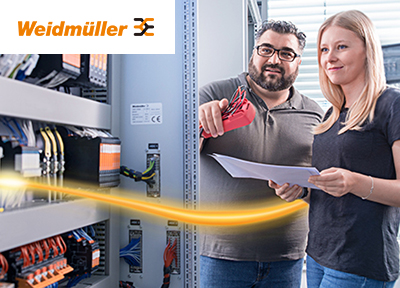CERN, the European Organization for Nuclear Research, is home to the Large Hadron Collider (LHC), a particle accelerator used by physicists to study the fundamental building blocks of all things. LHC is the result of collaboration between 10,000+ scientists and engineers representing 500 academic institutes, laboratories, educational institutions and industrial companies worldwide.
Accelerator operation involves nuclear interactions between high-energy particles, which create ionizing-radiat

RAMSES integrates monitoring and control functions for CERN's Large Hadron Collider experiment.
RAMSES’ functional requirements include:
Monitoring radiation levels (on-line, local and remote displays) — Monitoring of ambient dose equivalent rates in the working environment from stray radiation or induced activityCONTROL ENGINEERING China版权所有, and measurement of radioactivity in released air and water;
Alarm functions (local and remote) — radiation-level alarms based on ambient dose equivalent rates控制工程网版权所有, technical alarms, and interlocks;
Long-term permanent and reliable data logging — measured values, events (radiation alarms, interlocks, system fault alarms, technical alarms), and system configuration and modifications.
CERN has designed its industrial automation project to do away with any silos of automation in order to create a completely integrated data environment that will result in a central communications center. This center also manages the conventional monitoring of water (pH, temperatureCONTROL ENGINEERING China版权所有, conductivity控制工程网版权所有, and turbidity), air quality, wind speed and direction, and provides ambient dose equivalent and ambient dose equivalent rate measurements in the LHC un


 在线会议
在线会议 论坛
论坛 专题
专题 工控直播
工控直播 新闻中心
新闻中心 子站
子站 技术
技术 社区
社区


 2025 (第十四届) 全球自动化和制造主题峰会 ·深圳站
2025 (第十四届) 全球自动化和制造主题峰会 ·深圳站 2025 Raythink燧石红外热像仪有奖试用
2025 Raythink燧石红外热像仪有奖试用.jpg) 立即获取Fluke在线红外热像仪解决方案白皮书
立即获取Fluke在线红外热像仪解决方案白皮书 2025电子及半导体智能制造创新高峰论坛
2025电子及半导体智能制造创新高峰论坛.jpg) 电机与变频驱动故障排除白皮书免费下载
电机与变频驱动故障排除白皮书免费下载


























